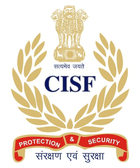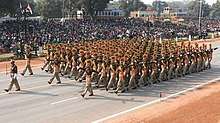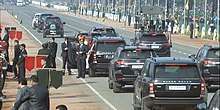Central Industrial Security Force
The Central Industrial Security Force (CISF) (established in its present form: 15 June 1983) is a Central Armed Police Force in India.
| Central Industrial Security Force | |
|---|---|
 | |
| Abbreviation | CISF |
| Motto | Protection and Security |
| Agency overview | |
| Formed | 10 March, 1969 |
| Employees | 148,371 Active Personnel[1] |
| Annual budget | ₹10,179.61 crore (US$1.4 billion) (2020-21)[2] |
| Jurisdictional structure | |
| Operations jurisdiction | India |
| Governing body | Ministry of Home Affairs (India) |
| Constituting instrument |
|
| Operational structure | |
| Headquarters | New Delhi, India |
| Minister responsible |
|
| Agency executive |
|
| Parent agency | Central Armed Police Forces |
| Notables | |
| Person |
|
| Website | |
| cisf.gov.in | |
 |
|---|
| This article is part of a series on the politics and government of India |
|
National coalitions
|
|
|
It was set up under an Act of the Parliament of India on 10 March 1969 with a strength of 2,800. CISF was subsequently made an armed force of India by another Act of Parliament passed on 15 June 1983. Its current active strength is 148,371 personnel.[4] In April 2017, the government raised the sanctioned strength from 145,000 to 180,000 personnel.[5] Among its duties are guarding sensitive governmental buildings, the Delhi Metro, and providing airport security.[6]
The CISF is governed by the Union Ministry of Home Affairs, it is headquarters are at New Delhi.
The CISF provides security cover to 300 industrial units, government infrastructure projects and facilities and establishments located all over India. Industrial sectors like atomic power plants, space installations, mines, oil fields and refineries, major ports, heavy engineering, steel plants, barrages, fertiliser units, airports and hydroelectric/thermal power plants owned and controlled by Central Public Sector Undertakings (PSUs), and currency note presses producing Indian currency are protected by CISF. It thereby covers installations all over India straddling a variety of terrain and climatic conditions. CISF also provides consultancy services to private industries as well as other organisations within the Indian government. The scope of CISF's consulting practice includes security consulting and fire protection consulting.
CISF is a unique organisation in the paramilitary forces of India, which works for seaways, airways and some of the major installations in India. In the CISF there are some reserved battalions which works with the state police to preserve law and orders. The CISF plays a major role in Disaster Management. The CISF has a 'Fire Wing' which helps during fire accidents in Industries where the CISF is on guard.

Raising and charter
It was set up under an act of Parliament on 10 March 1969 with a strength of around 2,800 personnel and as the name suggests, it was created for the better protection and security of industrial undertakings in the country. There was a limitation though, that industries to be provided protection should be wholly owned by the central government, which has since been modified so that the industries can now be a joint venture with the central government. However the role of CISF has undergone a diversification and it now also protects airports, seaports, metro rail networks, government buildings, heritage monuments (including the Taj Mahal and Red Fort), opium and alkaloids extractions, nuclear power plants, and space installations. It also specialises in VIP security as well as disaster management.
Structure and organisation
%2C_in_Ghaziabad_on_March_10%2C_2018.jpg)
The CISF is headed by an Indian Police Service officer with the rank of Director-General, assisted by an IPS officer in the rank of Addl. Director-General. The force is divided into seven Sectors (Airport, North, North-East, East, West, South and Training), and also has a Fire Service Wing.
The Airport Sector is commanded by an IPS officer in the rank of Addl. Director-General, assisted by an Inspector-General. The Airport Sector is divided into a number of Field Formation Units, one for each airport. Units at major international airports are commanded by a Deputy Inspector-General or Commandant; units at smaller airports by a Deputy or Assistant Commandant. The other six Sectors are each commanded by an Inspector-General, who is assisted by a Deputy Inspector-General.
The five regional Sectors are divided into Zones, each commanded by a Deputy Inspector-General. Within each Zone are a number of Units, each under the command of a Commandant, or a DIG for certain major Units. A Deputy Commandant serves as the second-in-command of most units, or as the head of a smaller unit. Within the Training Sector, the National Industrial Security Academy (NISA) is headed by an Inspector-General; the Fire Service Training Institute (FSTI) and six other recruit training centres are headed by Deputy Inspector-Generals.
The Financial Adviser of the CISF has been an Indian Revenue Service officer of the rank of Director and also has Dy Advisers from the Indian Audit and Accounts Service and Indian Civil Account Service.
Rank structure (gazetted officers)
| CISFs RANKS | POLICE RANKS |
|---|---|
| Director General (DG)
DG, CISF |
Director General of a State Police Force |
| Additional Director General (ADG) | C.P, ADG |
| Inspector General (IG) | IG, Joint C.P |
| Deputy Inspector General (DIG) | Additional C.P, DIG |
| Senior Commandant | SSP/DCP, IPS,(Grade Pay 8700 Rupees, Senior Administrative Grade) |
| Commandant | SP/DCP, IPS, (Grade pay 7600 Rupees, Junior administrative Grade) |
| Deputy Commandant (Dy Comdt) | SP/DCP, IPS (Grade pay 6600 Rupees, Senior Time scale) |
| Assistant Commandant (Asst Comdt) | Assistant superintendent of Police, IPS, (Grade pay 5400 Rupees, Junior Time Scale) |
Being a central Indian police agency and having high presence of Indian Police Service officers, CISF follows ranks and insignia similar to other police organisations in India. Non-gazetted (enrolled) officers and members use the same ranks as other Indian police forces. *There is no equivalence between the ranks of the defense forces and the police forces since there is no government established relativity in terms of rank.
CISF protection to Non-Nationalised Industry/ Corporate sector
The Indian Parliament on 25 February 2009 authorised the provision of Central Industrial Security Force security to private and cooperative establishments across the country for a fee with the passage of the CISF (Amendment) Bill, 2008.
The Bill, which was passed by Rajya Sabha on 19 February and Lok Sabha on 25 February 2009, also provides for deployment of CISF to protect Indian missions abroad and its participation in the UN peacekeeping operations.
CISF started providing security to the Infosys Bangalore and Pune campus on 31 July 2009.[7] The Infosys Mysore, the Reliance Refinery, Jamnagar and the Delhi Metro Airport Express Line are the latest additions to the list of private sector establishments to be placed under CISF cover. Mr. Manish Kumar Rai, Assistant Commandant, led the first contingent of CISF deployed at Infosys Bangalore
CISF has also started providing security to the Infosys Pune campus from 21 April 2011. [8]
Universities Security
Vice-Chancellor of Visva-Bharati University in Santiniketan has asked the Central Government to permanently deploy Central Industrial Security Force (CISF) personnel on its campus.[9]
On Nov 13th Union Home Ministry has accorded its approval for deployment of the CISF at the Visva-Bharati University in West Bengal also said that CISF will soon constitute a 'board of officers' who will conduct a security audit of the facility at Santiniketan.[10]
Airport security
The CISF is in charge of airport security at all commercial airports in India. Airport security, in the past, was under the control of airport police (under the relevant state government). However, following the hijacking of Indian Airlines Flight 814 in 1999, the topic of handing over security of the airports to the CISF was first proposed. While this proposal lay low for the next two years, the central government decided to respond to the security threat faced by all major nations of the world after the 2001 terrorist attacks happened in the United States (11 September 2001) and decided to adopt the suggestion. The Jaipur Airport was the first airport that came under the CISF's control on 3 February 2000. Following this, the majority of the commercial airports in India were brought under its purview.[11] As of now CISF is protecting a total of 61 international and domestic airports in the country.
Security for Delhi Metro
Security on the Delhi Metro is handled by the CISF Unit Delhi Metro Rail Corporation of CISF, who have been guarding the system ever since they took over from the Delhi Police in 2007.[12] Closed-circuit cameras are used to monitor trains and stations, and feed from these is monitored by both the CISF and Delhi Metro authorities at their respective control rooms.[13] Over 3500 CISF personnel have been deployed to deal with law and order issues in the system, in addition to metal detectors, x-ray baggage inspection systems and dog squads which are used to secure the system.[14] Intercoms are provided in each train car for emergency communication between the passengers and the driver.[15] Periodic security drills are carried out at stations and on trains to ensure preparedness of security agencies in emergency situations.[16]
Fire Wing
Besides providing protection, safety, and security to Industrial undertaking/installations, CISF also offers protection against Fire hazards. CISF has a highly specialised, trained and fully equipped fire wing. The first fire wing unit with a strength of 53 personnel was Inducted in FACT Cochin. As on date, the fire wing has been inducted in 91 units. The present strength of the Fire Wing is 6769 personnel.
The Fire wing which is an integral part of Central Industrial Security Force is the largest, well trained and equipped, fire fighting force in the Government Sector. It is known as an outstanding fire fighting force having an enviable record. It is providing fire coverage to Establishments varying from power plants, Refineries, Petro-Chemicals, fertilizers, Steel Plants Surface Transport, Heavy Industries, Space Application Center etc. Fire wing Induction in the Undertaking is not limited to providing manpower to fight fire alone. It also ensures availability of proper and adequate devices for fire prevention and fire fighting along with the fire fighting staff.
Special Security Group

In 2006, Central Industrial Security Force (CISF), on the basis of recommendations of the Intelligence Bureau, raised a special unit called Special Security Group (SSG) to provide security cover to people nominated by the Home Ministry. It came into existence on 17 November 2006. This unit is responsible for providing physical protection, evacuation, mobile and static security cover to persons who have been nominated by the Home Ministry.[17] :para 2.129 For a person to be eligible for security cover by CISF special unit, the intelligence bureau and other secret police agencies are required to specify the danger after a detailed 'threat analysis', which are often fudged for political and other considerations.[18][19] In addition to CISF the Government also utilizes the National Security Guard (NSG), CRPF, BSF, and ITBP for personal security cover.
Women in CISF
- Initially the recruitment and posting of Personnel to the CISF was restricted to men. In the year 1992, Mrs. Asha Sinha earned the distinction of being the First Woman Commandant of a Central Armed Police Forces in India when she was posted as Commandant, Mazagon Dock Shipbuilders Limited. Earlier the role of Women was allowed but limited to supervisory roles in the Central Armed Police Forces which includes the CISF.[20] The Parliamentary Committees of India for women's empowerment recommended greater roles for women in the CAPF including CISF. On these recommendations the Ministry of Home Affairs (India) declared reservation for women in constabulary in paramilitary forces, and later declared that they can also be inducted as officers in combat roles in all five Central Armed Police Forces.[20]
- The Union Home Minister announced that women's representation in the CRPF and CISF would be made 15 per cent.[21] On 5 January 2016, it was decided that 33 per cent posts at the constabulary level would be reserved for women in the CRPF and the CISF in a phased manner. The CISF is increasing the engagement of women at positions where there is greater Civilian-Police Interaction, specially in the Airports and the Metro Stations.[22][23]
See also
References
- "Annual Report 2016-17" (PDF). Ministry of Home Affairs, Government of India. Archived from the original (PDF) on 8 August 2017. Retrieved 12 August 2017.
- "Expenditure Budget - Ministry of Home Affairs - Police". Expenditure Budget | Union Budget of India. Ministry of Finance. Retrieved 6 June 2020.
- "Om Prakash Singh – Executive Record Sheet". Ministry of Home Affairs, Government of India. Archived from the original on 24 April 2016. Retrieved 11 January 2018.
- "CISP Official Website".
- "Press Information Bureau". Retrieved 29 April 2017.
- "Rajesh Ranjan takes charge as CISF chief". The Times of India. Times News Network (TNN). 12 April 2018. Archived from the original on 12 April 2018.
- "Infosys gets CISF cover". Hindu.com. 1 August 2009. Retrieved 20 June 2012.
- PTI. "Business Line : Industry & Economy / Info-tech : Infosys' Pune campus gets CISF cover". Thehindubusinessline.com. Retrieved 20 June 2012.
- Chopra, Ritika (30 October 2019). "Visva-Bharati V-C wants CISF: Campus security". The Indian Express. Retrieved 16 November 2019.
- "Home Ministry Approves CISF Cover for Visva-Bharati University in Bengal". News18.com. 13 November 2019. Retrieved 16 November 2019.
- Subhro Niyogi and Soma Ghosh (24 October 2001). "Mid-November target for CISF takeover of airport-Kolkata-Cities-The Times of India". The Times of India. Retrieved 20 June 2012.
- PTI (7 March 2007). "CISF to take over Delhi Metro security". The Times of India. Retrieved 20 June 2012.
- "Delhi metro parking areas to be bought under CCTV cameras – India – DNA". Dnaindia.com. 21 March 2010. Retrieved 20 June 2012.
- Megha Suri Singh (30 March 2010). "Moscow blasts put Metro security in alert mode". The Times of India. Retrieved 20 June 2012.
- Security. Delhi Metro
- TNN (26 March 2010). "Mock drills at 4 Metro stations". The Times of India. Retrieved 20 June 2012.
- MHA (2016). "Ministry of Home Affairs Annual Report 2015-2016" (PDF). New Delhi: Ministry of Home Affairs. Archived from the original (PDF) on 25 June 2017. Retrieved 30 May 2016.
- Ahuja, Rajesh (29 May 2016). "Staggering rise in VIP protectee list: 454 people in 2016". New Delhi: Hindustan Times. Retrieved 30 May 2016.
- DNA (15 June 2016). "Centre removes CISF security cover to Amar Singh". DNA. Retrieved 19 June 2016.
- https://economictimes.indiatimes.com/news/defence/government-allows-women-to-be-combat-officers-in-all-central-armed-police-forces/articleshow/51380021.cms
- https://www.telegraphindia.com/india/women-quota-in-crpf-cisf-to-be-made-15-per-cent/cid/1681181
- https://www.livemint.com/Politics/lFSQdbCGziERnrTywVZeJN/CISF-to-deploy-more-women-personnel-on-Delhi-Metro.html
- https://www.shethepeople.tv/news/cisf-inducts-1600-women-constables
External links
| Wikimedia Commons has media related to Central Industrial Security Force. |